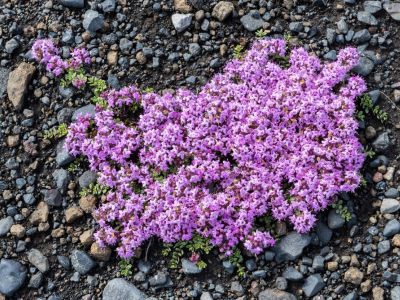Creeping Thyme Facts
Thymus praecox is a low-growing perennial hardy in USDA hardiness zones 4-9 with fairly minimal requirements. An evergreen with lightly haired foliage, this tiny-growing creeping thyme varietal — rarely over 3 inches or 7.5 cm. — will appear in low, dense mats, which sprawl randomly and quickly fill in areas as a ground cover. T. serpyllum is another creeping thyme variety. Just like other thyme varieties, creeping thyme is edible with a flavor and aroma akin to mint when crushed or steeped for teas or tinctures. To harvest creeping thyme ground cover, either remove the leaves from the stems or dry them by snipping from the plant and hanging them upside down in a dark, well-aerated area. Harvest creeping thyme in the morning when the essential oils of the plant are at their peak. Another creeping thyme fact is despite its enticing odor, growing creeping thyme ground cover is deer resistant, making it an ideal landscape candidate in areas frequented by them. Creeping thyme is also capable of withstanding tromping upon by rambunctious kids (making it kid resistant as well!), which makes it an exceptional planting choice anywhere that has frequent foot traffic. Flowering creeping thyme is very attractive to bees and is a nice addition to a garden focused on honeybees. In fact, the pollen from the blooming thyme will flavor the resulting honey.
How to Plant Creeping Thyme
As mentioned, growing creeping thyme is a simple process due to its compatibility in a variety of soils and light exposures. Although this ground cover prefers well-drained lightly textured soils, it will grow quite well in less than desirable medium and thrive from full sun to light shade environments. Soil should be kept moist but not wet, as the growing creeping thyme plant is susceptible to root drowning and edema. The soil pH for growing creeping thyme plants should be neutral to slightly alkaline. Creeping thyme ground cover can be propagated via stem cuttings or divisions and, of course, can be purchased from the local nursery as either established plantings or seeds. Cuttings from the creeping thyme plant should be taken in the early summer. Start seeds when growing creeping thyme indoors or they may be sown in the spring after the danger of frost has passed. Plant creeping thyme 8 to 12 inches (20-30.5 cm.) apart to allow for its spreading habitat. Prune creeping thyme ground cover in the spring to maintain a compact appearance and again after the small, white flowers are spent if additional shaping is preferred.
